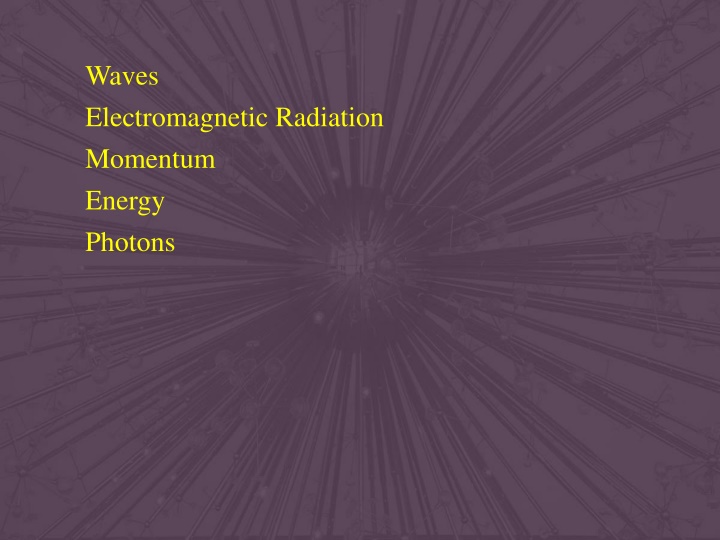
Waves, Electromagnetic Radiation, and Energy
Explore the fundamentals of waves, electromagnetic radiation, momentum, energy, and photons. Learn about the key features of waves and electromagnetic radiation, their behavior, properties, and applications in various fields like sound waves and visible light. Delve into the fascinating world of electromagnetic waves and their significance in modern science and technology.
Download Presentation

Please find below an Image/Link to download the presentation.
The content on the website is provided AS IS for your information and personal use only. It may not be sold, licensed, or shared on other websites without obtaining consent from the author. If you encounter any issues during the download, it is possible that the publisher has removed the file from their server.
You are allowed to download the files provided on this website for personal or commercial use, subject to the condition that they are used lawfully. All files are the property of their respective owners.
The content on the website is provided AS IS for your information and personal use only. It may not be sold, licensed, or shared on other websites without obtaining consent from the author.
E N D
Presentation Transcript
Waves Electromagnetic Radiation Momentum Energy Photons
Waves A wave is a propagating disturbance. For example: Water wave. Gravity and pressure make the wave propagate. Stadium wave. Sound wave: compression and expansion. The disturbance moves through space, but material in the medium just oscillates back and forth. Usually waves involve periodic oscillations.
Key features of a wave are: Period of oscillation [sec] or frequency of oscillation [sec-1] Wavelength of oscillation [m] Speed (more accurately, velocity) of propagation [m/sec] Amplitude [units depend on the kind of wave] Related by v = (wavelength/period) = wavelength frequency Examples: wave on a rope, water wave, sound wave.
Key features of a wave are: Period of oscillation [sec] or frequency of oscillation [sec-1] Wavelength of oscillation [m] Speed (more accurately, velocity) of propagation [m/sec] Amplitude [units depend on the kind of wave] Sound waves in air: Speed = 300 m/sec. Amplitude determines volume. Frequency determines pitch. 1 sec-1 = 1 Hertz (Hz) Piano ranges from about 30 Hz to about 4000 Hz. Middle C is about 260 Hz, wavelength (300/260) = 1.15 m.
Electromagnetic waves Experiments around 1800 showed light behaves like a wave, exhibiting diffraction. But what is waving? James Clerk Maxwell, building on experimental results by Michael Faraday and others, showed (1864): Changing electric field produces a magnetic field. Changing magnetic field produces an electric field. Maxwell s equations allow traveling electromagnetic waves. Calculated speed matched measured speed of light, In 1887, Heinrich Hertz confirmed existence of EM waves, building what is effectively the first radio transmitter & receiver.
Electromagnetic radiation EM radiation: waves of electric and magnetic fields that propagate through space. Visible light is EM radiation with wavelength 400 700 nm (1 nm = 10-9 m), wavelength determines color. All forms of EM radiation travel (in empty space) at c = 300,000 km sec-1 = 3 108 m sec-1 Similar to Thorne figure P.2
Electromagnetic radiation Image credit: Wikipedia WOSU at 89.7 MHz Wavelength = 3 108 m sec-1 / (89.7 106 sec-1) = 3.34 m
Momentum and momentum conservation Momentum = tendency to keep going Object of mass m moving at velocity v with v << c has momentum p = m v (vector, same direction as velocity) Acceleration = rate of change of velocity, and F = ma, so F = rate of change of momentum Newton s 3rd law totalmomentum doesn t change if there are no external forces. Momentum is conserved.
Energy and energy conservation Energy = ability to do something Physics gives precise definition Different forms: kinetic (energy of motion), thermal, electrical Potential energy, available to be tapped (gravitational, chemical) Energy can be transformed, but total energy is always conserved. Key to understanding many problems is follow the energy
Photons EM radiation has many wavelike properties. In 1905 Einstein (building on work by Max Planck) proposes that EM radiation travels in discrete energy packets, a.k.a. photons Particles of light. Energy depends on wavelength: E = h c / = wavelength of photon E = energy of photon c = speed of light Momentum of a photon is p = h / h = Planck s constant Short wavelength photons (gamma-ray, X-ray) have more energy, more momentum.
